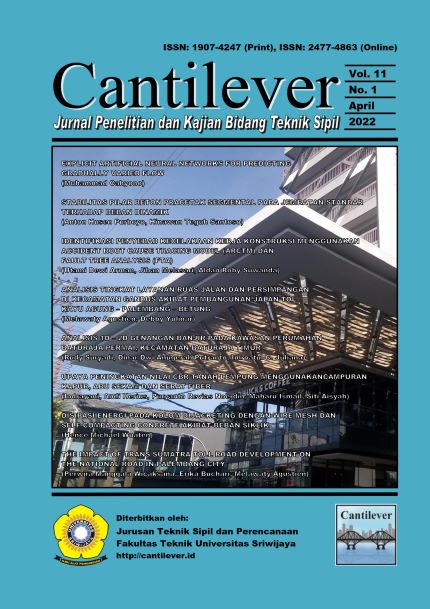Stabilitas Pilar Beton Pracetak Segmental Pada Jembatan Standar Terhadap Beban Dinamik Stability of Segmental Precast Concrete Piers on Standard Bridges Against Dynamic Loads
Main Article Content
Abstract
The use of precast technology in the manufacture of segmental components for the bridge substructure is one application that can be used in the acceleration of bridge construction. Better concrete quality and precision are two advantages that can make precast technology a solution in accelerating bridge construction. Commonly, segmental precast concrete piers are not designed to resist earthquake loads; however, the use of segmental piers systems is still possible in seismic zones by limiting additional dead loads. This study discusses the load limitation using the dynamic response calculation methodology of segmental precast concrete pillar structures to the El Centro (1940) earthquake load by varying the slenderness of the piers/column between 22 to 100. Examination of the stress combination due to axial load (DL) and inertia load due to the earthquake is carried out to find out how much residual stress can be accommodated by the piers/columns. Additional dead load (WADD) is obtained by using Newton's second law by dividing the allowable additional inertial load based on the residual stress to the peak ground acceleration. The calculation results show a good correlation between piers’/columns’ slenderness and the proportion of additional dead load (WADD) to dead load (WDL), so that the applicability of using segmental precast concrete piers/columns in seismic zones can be predicted earlier through this correlation.
Downloads
Article Details
Alashari, M. 2016. Accelerated Bridge Construction (ABC), A Better Approach to Bridge Construction?. International Journal for Innovation Education and Research, Vol: 4 No.: 8. 44/1 Kallyanpur Main road, Mirpur, Dhaka, Bangladesh
Alexander, C. 1979. Principles of Structural Stability Theory. Prentice-Hall Inc., Englewood Cliffs, New Jersey.
Ali Kahn, M., 2015. Accelerated Bridge Construction Best Practice and Techniques. Elsevier Inc. The Boulevard, Langford Lane, Kidlington, Oxford OX5 1GB, UK225 Wyman Street, Waltham, MA 02451, USA.
ASTM. 2004. A 36/A 36M – 04 Standard Specification for Carbon Structural Steel.
Azizinamini, A., 2020. Accelerated Bridge Construction. ASCE Journal of Bridge Engineering/ Volume 25 Issue 12 - December 2020.
Billington, S. L., Barnes, R. W. dan Breen, J. E. 1999. A Precast Segmental Substructure System for Standard Bridges. PCI Journal, July-August 1999, Volume: 44, Issue: 4, Page number: 56-73.
Billington, S. L., Barnes, R. W. dan Breen, J. E. 2001. Alternate Substructure Systems For Standard Highway Bridges. Journal of Bridge Engineering, Vol. 6, No. 2, March- April 2001, Page number: 87-94.
Chopra, A. K. 2012. Dynamics of Structures 4th Ed. Pearson Education, Inc., publishing as Prentice Hall, One Lake Street, Upper Saddle River, NJ 07458.
Concrete Bridge Development Group, 2005. Fast Construction of Concrete Bridge. The Concrete Society, Riverside House, 4 Meadows Business Park, Station Approach, Blackwater, Camberley, Surrey, CU17 9AB.
Jia, J., Zhang, K., Wu, S., Guo, Y., Du, X., & Wang, X. 2020. Seismic performance of self-centering precast segmental bridge columns under different lateral loading directions.https://doi.org/10.1016/j.engstruct.2020.111037.
Kristensen, J. S. 2012. Precast Segmental Bridge Construction – An Introduction. A SunCam online continuing education course, https://www.suncam.com.
Marsh, L. 2014. Precast Substructures Comparison of Non-seismic and Seismic Connection Details. Webinar Presentation, ABC Center at Florida International University
Newmark, N. M. dan Hall, W. J. 1982. Earthquake Spectra and Design. Earthquake Engineering Research Institute. 2620 Telegraph Avenue. Berkeley, California 94704.
Wang, J & Fan, Z, 2020. Detecting of the Crack and Leakage in the Joint of Precast Concrete Segmental Bridge Using Piezoceramic Based Smart Aggregate. Sensors 2020, 20, 5398; doi:10.3390/s20185398.
Wang, J. 2000. Pier and Columns. Bridge Engineering Handbook. Ed. Wai-Fah Chen and Lian DuBoca Raton: CRC Press, 2000.

This work is licensed under a Creative Commons Attribution-NonCommercial 4.0 International License.
Authors who publish with this journal agree to the following terms:
- Authors retain copyright and grant the journal right of first publication with the work simultaneously licensed under a Creative Commons Attribution-NonCommercial 4.0 International License that allows others to share the work with an acknowledgment of the work's authorship and initial publication in this journal.
- Authors are able to enter into separate, additional contractual arrangements for the non-exclusive distribution of the journal's published version of the work (e.g., post it to an institutional repository or publish it in a book), with an acknowledgment of its initial publication in this journal.
- Authors are permitted and encouraged to post their work online (e.g., in institutional repositories or on their website) prior to and during the submission process, as it can lead to productive exchanges, as well as earlier and greater citation of published work (See The Effect of Open Access).
